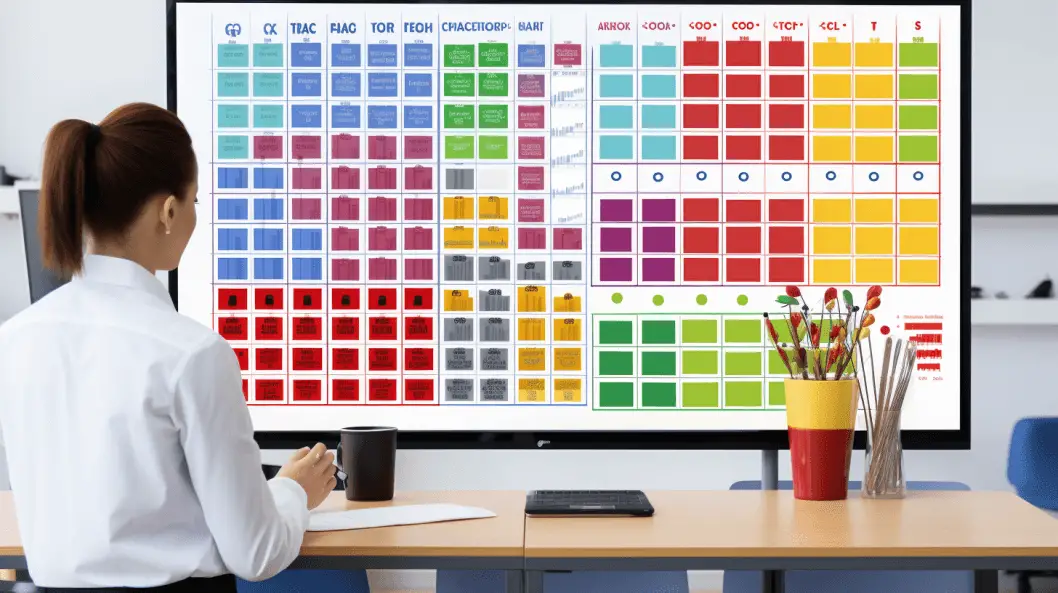The HACCP (Hazard Analysis and Critical Control Points) risk assessment matrix is a tool used in food safety management systems to identify and evaluate potential hazards and determine critical control points. This matrix provides a systematic and structured approach to assessing food processing and manufacturing risks
Organizations can implement effective control measures to prevent, eliminate, or reduce hazards to an acceptable level by identifying critical control points.
This article aims to provide a comprehensive understanding of the HACCP risk assessment matrix, including its definition, the process steps involved in its development, and its components.

Foreign Material Risk Assessment
Definition of HACCP Risk Assessment Matrix
A HACCP Risk Assessment Matrix is a tool used in the food industry to identify and assess potential hazards that could otherwise affect human health or the safety of food products.
It is a systematic approach that helps organizations to prioritize risks and implement control measures to prevent or eliminate them.
At the heart of every reputable food business operator is an acceptable reference framework for all food safety issues, like the Codex HACCP. This provides effective prerequisite programs that continuously guide daily production or batch-basis processes.
Common prerequisite programs underscore everything from sanitary design principles that dictate facility design to the rigorous storage between packaging stages.
The scientific core of these operations often comes down to a comprehensive analysis summary table, which may include data on potential foodborne pathogens such as Salmonella serotype Enteritidis.
Companies can identify and mitigate unacceptable health risks by examining the cells of Salmonella and the conditions that encourage the multiplication of pathogens.
Chemical Control plays a role here, too, with chemical measurements and methods helping ensure wholesome food production.
Effective training is paramount, with Employee training records being a mandatory element that tracks learning progress and confirms the acquisition of relevant knowledge. Examples of decision trees are often used as training aids to simplify complex processes, fostering a better understanding among employees about their roles in maintaining food safety.
The economic gain for food companies that strictly adhere to food safety practices is substantial. Everything from producing low-acid canned foods to regular food items must undergo stringent control measures to ensure they are safe for consumption.
These measures can range from analyzing food composition to safeguard against food fraud to applying sanitary conditions for food processing and storage.
The context of food production is riddled with potential hazards, from enteric pathogens to design deficiencies in Equipment design.
Hence, stages of hazard analysis become vital, as does the accurate identification of hazards. This often involves thorough analytical testing, including microbiological testing, which guides the development of process controls.
Sanitation and corrective action procedures are other subsequent steps necessary to maintain sanitary and basic conditions. These procedures are continually assessed, and updates are documented for future reference.
Monitoring records play a crucial role in food safety. CCP Monitoring, or monitoring of Critical Control Points, helps prevent the loss of control that could lead to consumer illness.
Examples of monitoring activities could be checking the moisture level in cooked materials or reviewing the environmental conditions during the thermal process.
The activity of verification and subsequent Verification reports form an essential aspect of verification. These ensure that control action measures, such as Effective pest control programs and end-product testing, are working as they should.
The goal? To reduce the risk of severe illness, thereby the food safety team protecting public health and reinforcing the trust in food manufacturing companies. It all ties back to employee health and a steadfast commitment to food safety, hallmarks of any reliable food business.
The benefits of using a HACCP Risk Assessment Matrix include improved food safety management, enhanced decision-making processes, and compliance with regulatory requirements.
Benefits of Using a HACCP Risk Assessment Matrix
Utilizing a HACCP risk assessment matrix provides numerous advantages, as it offers a systematic approach for identifying and evaluating potential hazards in food production processes.
This tool enables organizations to assess the severity of each identified hazard and the likelihood of its occurrence, helping prioritize control measures effectively.
Using a risk assessment matrix also enhances the overall understanding of the risks associated with food production, allowing for informed decision-making and resource allocation.
Furthermore, it provides a standardized framework for stakeholder communication, promoting consistency and clarity in risk assessment discussions
Additionally, the matrix facilitates the identification of critical control points, enabling organizations to focus their efforts on areas that pose the highest risks.
Incorporating key contextual, relevant keywords, such as HACCP, risk assessment matrix, and benefits, this article section provides a comprehensive overview of the advantages of using a HACCP risk assessment matrix.
Process Steps for Developing a HACCP Risk Assessment Matrix
The process steps for developing a HACCP risk assessment matrix involve several key points.
First, it is important to establish the process steps in the food chain, which includes identifying all the stages from production to consumption.
Next, potential hazards should be assessed and critical control points (CCPs) should be identified. These CCPs are where hazards can be prevented, eliminated, or reduced to an acceptable level.
Once the CCPs are identified, critical limits must be defined for each control point. These limits are the criteria that must be met to ensure the hazards are effectively controlled.
Monitoring procedures should then be implemented at each control point to meet critical limits.
Finally, corrective actions should be established in case the critical limits are not met to address any deviations from the established standards.
Establish the Process Steps in the Food Chain
To establish the process steps in the food chain, it is essential to carefully analyze and map out each stage of production, from the sourcing of raw materials to the final distribution of the finished product. This is crucial in implementing a HACCP risk assessment matrix, a systematic approach to identifying and controlling food safety hazards.
The following are three important components of establishing the process steps in the food chain:
- Hazard Analysis: This step involves identifying and evaluating potential hazards at each production stage, such as biological, chemical, or physical.
- Critical Control Points (CCPs): These are specific points in the production process where control measures can be applied to prevent, eliminate, or reduce identified hazards to an acceptable level.
- Control Measures, Monitoring, and Corrective Actions: This involves implementing control measures, monitoring them regularly, and taking corrective actions when necessary to ensure that food safety risks are effectively managed.
Following these steps and incorporating them into a comprehensive food safety plan can minimize the risk of foodborne illnesses, and consumers can be assured of safe, high-quality food products.
Assess Potential Hazards and Identify Critical Control Points
Assessing potential hazards and identifying critical control points in the food supply chain is a fundamental step toward ensuring the safety and quality of food products. This process involves a thorough analysis of the food production process to identify potential hazards and determine the critical control points where risks can be controlled.
hazard identification procedure is followed to systematically identify hazards such as biological, chemical, and physical contaminants that can compromise food safety. Once hazards are identified, a decision-making process is employed to determine the critical control points.
These are steps in the production process where controls can be implemented to prevent, eliminate, or reduce the identified hazards to an acceptable level.
To add a level of sophistication, a table can be incorporated to organize the assessment and decision-making process, with columns representing the steps and rows representing the risk levels associated with each step.
Define Critical Limits for Each Control Point
Defining critical limits for each control point is an essential step in ensuring the safety and quality of food products. It establishes specific criteria that must be met to prevent or reduce hazards to an acceptable level.
These critical limits act as boundaries that separate safe and unsafe conditions. They serve as a reference point for decision-making in HACCP (Hazard Analysis and Critical Control Points) systems.
When establishing critical limits, several factors need to be considered. This includes the potential hazards associated with raw materials, the identification of critical control points, and the storage conditions of the food products.
Food safety hazards such as microbial growth, chemical contamination, or physical hazards can be effectively controlled by setting these limits. This minimizes the risk of illness or harm to consumers.
The decision tree approach can be employed to determine appropriate critical limits. It considers scientific evidence, regulatory requirements, and industry best practices.
Implement Monitoring Procedures at Each Control Point
Implementing monitoring procedures at each control point is crucial for ensuring the effectiveness of the critical limits established in the HACCP system. It allows for ongoing verification of the control measures and timely detection of deviations that may threaten food safety and quality.
Monitoring procedures involve regular checks and observations to ensure the control measures are followed correctly and the critical limits are met. This includes monitoring parameters such as temperature, time, pH levels, and visual inspections.
Continuous monitoring ensures that any deviations from the critical limits are identified promptly, allowing for corrective actions to be taken to prevent the production of unsafe food products.
Training plays a key role in implementing monitoring procedures, as it ensures that employees understand the importance of monitoring and are equipped with the necessary skills to carry out the tasks effectively.
Monitoring procedures are a fundamental part of the HACCP system, providing key elements for risk management tools such as risk matrices and biological risk assessments
Implementing monitoring procedures at each control point, food businesses can effectively manage food safety risks and produce safe food products.
Establish Corrective Actions When Needed
Establishing corrective actions when needed ensures that any deviations or non-conformities identified during monitoring procedures are promptly addressed and rectified, safeguarding the integrity and safety of food products.
This step is crucial in the implementation of the HACCP risk assessment matrix. When corrective actions are established, it allows for identifying and eliminating potential hazards or risks that may compromise the food safety hazard, and quality of food products.
To effectively establish corrective actions, the following measures should be taken into consideration:
- Investigate the root cause of the deviation or non-conformity.
- Develop and implement corrective procedures to address the identified issue.
- Monitor the effectiveness of the corrective actions to ensure that the problem is resolved and does not reoccur.
Food businesses can maintain the highest standard of their food safety controls and prevent the occurrence of potential hazards, as identified by the HACCP risk assessment matrix.

Definition Of Hazard And Risk Assessment
Verify the System is Working Properly
Verification is a crucial step in the HACCP process as it ensures that the risk assessment tools used in the matrix are effective in managing food safety risks.
This involves conducting qualitative food safety risk assessments and utilizing food safety risk matrices to evaluate the level of risk associated with various food hygiene hazards.
The verification process also requires defining criteria for food safety and conducting comprehensive verification activities to ensure that the system functions as intended.
Verification reports play a significant role in documenting the results of these activities and provide a means for assessing the effectiveness of the HACCP system in mitigating risks
Components of a HACCP Risk Assessment Matrix
This discussion will focus on the key components of a HACCP Risk Assessment Matrix.
- Hazard analysis involves identifying and evaluating potential hazards during food production.
- Risk matrices/levels of acceptable risks help determine the severity and likelihood of each identified hazard, allowing for prioritization and control measures.
- A food safety plan’s decision trees/key elements outline the steps and considerations for managing hazards effectively.
- Lastly, the discussion will touch on the significance of chemical hazards in the food industry and the importance of addressing them in the risk assessment process.
Hazard Analysis
Conducting a thorough hazard analysis is essential for identifying potential risks and ensuring the safety of food products in the HACCP risk assessment matrix.
Hazard analysis in food science involves systematically assessing the food industry’s conditions, materials, and processes to identify potential hazards that may pose a consumer risk.
This analysis is a critical element of the HACCP risk assessment matrix, as it helps to prioritize control measures and preventive actions.
The hazard analysis considers various physical hazards, biological, and chemical hazards.
It also considers the specific requirements and regulations of the food operation and processing plants.
References to scientific studies, industry guidelines, and regulatory requirements are made to ensure the accuracy and reliability of the hazard analysis process.
Risk Matrices/Levels of Acceptable Risks
Evaluating risk matrices and determination of acceptable levels of risk is an integral part of ensuring the safety of food products in the HACCP framework.
Risk matrices assess and categorize the severity and probability of hazards occurring in food production. This allows for a systematic approach to identifying potential risks and prioritizing control measures.
The levels of acceptable risks are determined based on the risk rating assigned to each hazard. The risk rating considers factors such as the complexity of monitoring, the likelihood of occurrence, and the potential for harm to consumers.
The HACCP plan can ensure adequate actions to prevent or minimize hazards by setting appropriate levels of acceptable risks. This supports continuous improvement and provides a structured assessment for illness caused by foodborne hazards.
Decision Trees/Key Elements of Food Safety Plan
One essential tool in ensuring the safety of food products is the use of decision trees. Decision trees provide a visual representation of the key elements of a food safety program, allowing for a clear and logical flow of actions to be taken in response to potential food hazards above.
These key elements include hazard analysis, critical control points, critical limit determination, procedures for monitoring, critical limit deviation, and quality controls.
Decision trees help food safety professionals make informed decisions and implement appropriate control measures at each critical control point.
They also aid in identifying potential hazards and developing procedures to prevent or mitigate these hazards. Decision trees are typically presented as a block-type flow diagram, which outlines the steps involved in producing a finished product within a HACCP system.
Key ElementsDescriptionHazard analysisIdentification and evaluation of potential hazards that may occur in the food production processCritical control pointsSpecific points in the production process where control measures can be appliedCritical limit determinationEstablishing the maximum or minimum criteria that must be met at each critical control measure and pointProcedures for monitoringMethods to monitor and verify that critical limits are being metCritical limit deviationActions to be taken when a critical limit is not met
Key elements
Chemical Hazards in the
Chemical hazards in the food production process pose a significant threat to the safety and quality of food products. The HACCP risk assessment matrix is often utilized to manage these hazards effectively. This matrix allows for identifying, evaluating, and controlling chemical hazards at various stages of food production.
- Identification: The matrix helps in recognizing and understanding the specific chemical hazards present in the food production process.
- Evaluation: It enables a systematic assessment of the severity and likelihood of these hazards, considering factors such as concentration, exposure, and potential health effects.
- Control factors: The matrix assists in determining control measures to mitigate or eliminate chemical hazards, including monitoring, good manufacturing practices, and appropriate storage.
- Risk rating levels: By assigning risk ratings based on the matrix, priority can be given to high-risk hazards, ensuring they receive adequate attention and control measures.
Utilizing the HACCP risk assessment matrix, food safety management can proactively address chemical and biological hazards, minimizing the potential for severe health effects. It provides a structured approach to ensure the safety and quality of food products throughout the entire production process, including factors such as thermal processes and packaging materials.
Frequently Asked Questions
How is a HACCP Risk Assessment Matrix different from other risk assessment tools?
A HACCP risk assessment matrix differs from other risk assessment tools by focusing specifically on hazards related to food quality and safety. It uses a systematic approach to identify, evaluate, and control potential food production and processing risks.
Are there any legal requirements or industry standards that mandate using a HACCP Risk Assessment Matrix?
Legal requirements and industry standards mandate the use of a risk assessment matrix in certain sectors, such as the food industry. These regulations aim to ensure food safety and prevent potential hazards in food supply chains in accordance with HACCP principles.
Can a HACCP Risk Assessment Matrix be used in any industry, or is it specific to the food industry?
A HACCP risk assessment matrix can be used in various industries, not limited to the food industry. It provides a systematic approach to identifying, evaluating, and controlling hazards, ensuring the safety and quality of products and processes.
What are the common challenges faced when implementing a HACCP Risk Assessment Matrix?
Common challenges when implementing a risk assessment matrix in the HACCP system include a lack of expertise in risk assessment, difficulty identifying hazards and assessing hazards, inconsistent application of the matrix, and resistance to change within the organization.
Are there any best practices or tips for effectively using a HACCP Risk Assessment Matrix in a company’s risk management process?
When using a risk assessment matrix in a company’s risk management process, it is important to follow best practices. These include clearly defining criteria, ensuring consistent scoring, and regularly reviewing and updating the risk matrix to reflect company risk profile changes.

Definition Of Risk Assessment In Construction
Conclusion
The HACCP Risk Assessment Matrix is a valuable tool used in the food industry to both identify hazards and analyze potential hazards in the production process.
It consists of a grid that categorizes hazards based on their likelihood and severity, allowing for a systematic approach to risk assessment.
Developing a HACCP Risk Assessment Matrix involves hazard identification, hazard analysis, and risk evaluation
The matrix comprises various components: hazard description, risk rating, and control measures.
Using this matrix, food manufacturers can effectively manage and mitigate risks to ensure the safety of their products.

Chris Ekai is a Risk Management expert with over 10 years of experience in the field. He has a Master’s(MSc) degree in Risk Management from University of Portsmouth and is a CPA and Finance professional. He currently works as a Content Manager at Risk Publishing, writing about Enterprise Risk Management, Business Continuity Management and Project Management.

